
While it might seem strange to westerners that Microsoft would promote the new version of Windows with a burger joint, it actually points to the reality that dynamic tech ads like these are far more mainstream in Japan. You can see video of Japanese fast food lovers attempting to scarf down the gargantuan burger here.
 ViewSonic has recently introduced the VPC101, and it appears to be a nicely priced all-in-one desktop style PC. Of course, that nicely priced statement will most likely depend on your needs, but I am thinking extra house computer—something that will be able to stream some Pandora, play photo slideshows and maybe do some light surfing.
ViewSonic has recently introduced the VPC101, and it appears to be a nicely priced all-in-one desktop style PC. Of course, that nicely priced statement will most likely depend on your needs, but I am thinking extra house computer—something that will be able to stream some Pandora, play photo slideshows and maybe do some light surfing.With that, the VPC101 is similar in specs to a netbook. And I say that because it has an all-to-familiar set of specs which include a 1.6GHz Intel Atom 230 processor, integrated GMA 950 graphics, 1GB of RAM and a 160GB hard drive. And being an all-in-one PC it also has an 18.5-inch display that offers a 1366 x 768 resolution. Additionally, this particular model is running Windows 7 Home Premium and that means it comes with the touchscreen features.
Price wise, the list is $650 and it is expected to be available sometime next month

PlayStation 3 owners will now similarly be able to ruin their lives as Netflix is going to add the service to Sony's big black box before the year is up. It looks like you'll need to get a free disc sent to you through Netflix to get things started — whereas Xbox users only have to download an app for the service — though it's unclear whether it's just a simple one-time install or a disc you have to insert whenever you watch movies.
Other than that you just need a Netflix account, even one as cheap as $9. The PlayStation's online network is free, as opposed to Microsoft's premium Xbox Live Gold service, which is required if you want to get your Netflix stream on.
New website tracks unusual and unfair iPhone app rejections
iPhone developers have long been frustrated by Apple when they have an application rejected for inclusion on iTunes. One such developer has decided that it is time to make public the kind of apps that are being rejected and, if known, the reasons. The new website is appropriately named App Rejections.
Besides rejections, some approvals are also posted on the website. Ultimately, it seems that the greatest contribution of the website is that it helps developers gain some knowledge into the iPhone app approval process which many have found “semi-random”. Sometimes, the website can also generate publicity to help a rejected or limbo app make it through the approval process. If you are looking to contribute to the website with a rejected iPhone app of your own you can Twitter @redglassesapps.
Adam Martin, the website’s author, is based in the UK and works as an online games and iPhone consultant. Since Apple does not wish to lift the cloak of secrecy around the app approval process it is nice to know there is one person who is trying create a map to navigate it. The website is not only valuable to developers, but to clients looking to have an iPhone app developed since some functionality may be a sure fire way to get an app rejected.

We like to keep an eye on the adoption of mobile video broadcasting applications around these parts. It’s a mighty competitive space, with Qik, Kyte, Flixwagon, Ustream and a number of others all taking a stab at what is essentially the same idea. While the idea as a whole has yet to really take off as something that everyone does, its one that just about everyone seems to appreciate once it’s explained to them. Therein lies the challenge: how do you tell people that such services exist?
One approach is to get it on the handsets right out of the box. If it’s hard to get them to come to you, why not go to them?
The only one of the lot we’ve seen do this so far is Qik, who managed to convince Nokia to pre-install Qik on all of their S60-based phones beginning in July. Today, they’ve announced a new factory-loading partner: Samsung.
After what Qik says was “months of rigorous testing and certifications”, Samsung is now pre-loading the application onto Omnia II handsets at the factory. Samsung managed to sell many millions of the first Omnia worldwide – if the sequel is anywhere near as successful, Qik ought to see a pretty good amount of growth in the coming weeks.





Here’s a demo video for Makibishi you should watch before you buy:

TomTom, the maker of the GPS equipment and software, has Black Friday deals in place that you may be looking for if you’re in the market for a personal navigational device this holiday season. The Amsterdam, Netherlands-based GPS vendor has discounted a number of personal navigational devices from its rich portfolio and some of the price cuts are pretty substantial, up to $120. Some of the noteworthy deals include the following items:
- ONE 130 is $79.95, down from $129.95 (a $50 saving)
- ONE 140S is $99.95, down from $199.95 (a $100 saving)
- XL 335S is $119.95, down from $239.95 (a $120 saving)
- GO 340 S LIVE is $199.95, down from $249.95 (a $50 saving)
The new GO, ONE, and XL family of devices feature the U.S. and Canada maps, TomTom Map Share, IQ Routes technology, advanced lane guidance, and seven million points of interest. While those software features are comparable with TomTom’s iPhone app, TomTom’s dedicated devices beat GPS capabilities built into smartphones in many areas, including price, screen size, battery life, and a much better reception.

Now that the holiday shopping season is upon us you are probably trying to find that unique gift for a loved one. If they are a gadget lover then perhaps you can commission them a unique iPhone. One anonymous Australian businessman who works in the gold industry did just that. You can get a similar iPhone like his. It will just cost you over $3 million dollars.
Gizmag has reported that the luxurious iPhone, commissioned by Goldstriker International, has grabbed the title of the world’s most expensive mobile. The device was designed by Stuart Hughes of Liverpool, England and took ten months to create. Some of the specs of the iPhone include a casing made of 22ct solid gold and 136 diamonds which outline the front bezel. The rear of the phone features a logo made up of 53 diamonds. Probably the most eye-catching addition to the phone is the navigation button which is made of a single-cut, rare diamond weighing 7.1cts.
Anyone who carries an iPhone worth over $3 million either really loves the iPhone or wants to show that they have money to burn. As a status symbol, I suppose carrying around the most expensive mobile phone in the world is easier than a Ferrari or a new yacht. Unfortunately, like most smartphones, it will be obsolete in a few years.

There's also one for Mac fans, as seen down below.
Nokia debuts two entry-level sliders, the 6700 and 7230.
![Screen shot 2009-11-24 at [ November 24 ] 10.07.57 AM Screen shot 2009-11-24 at [ November 24 ] 10.07.57 AM](http://www.mobilecrunch.com/wp-content/uploads/2009/11/Screen-shot-2009-11-24-at-November-24-10.07.57-AM.png)
It’s not all N900s and lollipops in the Nokia kingdom, folks. Nokia has made a big chunk of their piggy bank with the entry level stuff, and they’ve got two new ones for that market today.
The grander of the two is the Nokia 6700, which comes in a very iPod-Nano-esque array of colors. For around $240 bucks unlocked, you’ll get a 5 megapixel camera with dual LED flash, Bluetooth 2.1 + EDR, FM radio, microSD expandability, 2.2″ QVGA display, and HSDPA/HSUPA.
![Screen shot 2009-11-24 at [ November 24 ] 10.08.09 AM Screen shot 2009-11-24 at [ November 24 ] 10.08.09 AM](http://www.mobilecrunch.com/wp-content/uploads/2009/11/Screen-shot-2009-11-24-at-November-24-10.08.09-AM.png)
The Nokia 7230 tones things down a bit in terms of specs and hues. $150 bucks gets you a 2.4″ display, 3.2 megapixel camera, FM radio, microSD expandability, and Bluetooth.
Look for both handsets in Q1 of next year.

EIZO Japan is preparing to launch a new 22-inch LCD monitor ‘FlexScan SX2262W’ for the Japanese market. This widescreen monitor makes use of Vertical Alignment (VA) panel and provides 1920 x 1080 Full HD resolution, 6ms GTG response time, 1,000:1 contrast ratio, 280 cd/m2 brightness and covers 95% of the Adobe RGB color space. In terms of connectivity ports, it offers two USB, dual-DVI and DisplayPort. The FlexScan SX2262W will be available in Japan starting on January 12th for an estimated retail price of $811. [InsideHW]


- Toshiba Satellite T135:
- 13.3-inch diagonal widescreen HD TruBrite™ LED Backlit display
- Windows 7 Home Premium operating system
- Intel® Pentium® SU4100 processor or Intel® Pentium® SU2700 processor
- DDR3 RAM
- Starting at 250GB (5400 RPM) HDD
- 802.11b/g/n wireless and 10/100 Ethernet
- Bluetooth V2.1 + EDR (available on select models)
- Toshiba Hard Drive Impact Sensor
- Touch Pad with Multi-touch Control
- Weight - 3.88 lbs.
- Long-life 6-cell battery delivering up to 9 hours of battery life
- One eSATA/USB combo port with USB Sleep-and-Charge and two USB 2.0 ports
- HDMI port
- Built-in Webcam with Toshiba Face Recognition, stereo speakers and microphone
- Toshiba PC Health Monitor
- 5-in-1 Memory Card Reader Slot
Shiny shiny
Windows 7 support
Pricing details

Image Gallery (3 images)
Global undertaking

It's the NVIDIA rumor that won't die: no, not the one where the GPU maker buys tiny VIA, but the other one, where it jumps feet-first into competition with both Intel and AMD by producing an x86 processor of its own. The idea has cropped up again in an analyst note from Doug Freedman of Broadpoint AmTech, in which Freedman claims that NVIDIA has been hiring former Transmeta engineers to work on a secret x86 processor that will appear sooner rather than later. In the note seen by the EE Times, Freedman emphasizes that NVIDIA not will take on Intel's Core i5/i7 lineup. Rather, the company's plan is to it attack the mid-range to low-end market, possibly competing with AMD in the value segment.
Before unpacking the rumor, let's lay out the full rationale for the "NVIDIA goes x86, competes with Intel head-on" idea.
First and foremost among the reasons cited for NVIDIA's alleged plans is the fact that we're about to make another turn on Sutherland's wheel of reincarnation, where graphics functionality will move back onto the CPU die. When this happens, NVIDIA's lucrative integrated graphics processor business is, of course, toast, which has to be one reason why the company went ahead and euthanized it a bit early.
This turn of the wheel is interesting because it's not just that the integrated graphics processors (IGP) will move from the chipset to the CPU, but retain their same basic degree of specialization. Rather, both the integrated GPUs that go onto the CPU die and the more discrete models are essentially becoming many-core, general-purpose processors (albeit specialized for multithreaded throughput and floating-point). This makes the situation even more ominous for NVIDIA, because not only will Intel and AMD take their IGP market from them, but even in the discrete GPU market NVIDIA will also end up with a generalized processor that competes with x86.
The ultimate point is that in both the discrete and integrated GPU markets, NVIDIA is already destined to compete directly with Intel and AMD, which means that an actual x86 product from NVIDIA means only that NVIDIA has decided to fight x86 with x86, as opposed to fighting it with some non-x86 architecture.
What about those Transmeta engineers?
The fact that NVIDIA has hired a bunch of ex-Transmeta guys doesn't necessarily mean anything at all for this supposed x86 processor.As the launch of Apple's Snow Leopard, with its pervasive use of LLVM, makes clear, just-in-time compilation (JIT) is the way that everyone is going to tackle the many-core problem, at least in the near-term. This is because even when you know at compile-time that your target architecture is x86, you probably don't know the number of x86 cores that users will have available, so you can delay some parts of the compilation process to runtime so that the output precisely fits the target machine's hardware.
If you're already using JIT by default to map code to hardware at runtime, then you can just target non-x86 cores as well, should any be present. This is how Snow Leopard is able to take advantage of GPU hardware alongside multicore x86 for general-purpose computing tasks.
Because the software side of the GPU is already headed towards a heavy reliance on binary translation techniques, it makes sense that NVIDIA is scooping up Transmeta guys regardless of any plans to produce a CPU. So, again, the Transmeta hires don't necessarily augur much of anything.
In fact, the notion that NVIDIA might produce a non-x86 processor but use binary translation to sell it as an x86 competitor appears completely ridiculous. Now, this doesn't mean it won't happen—it just means that if it does, it'll fail miserably and we'll all have a laugh.
As for whether NVIDIA is actually planning an x86 CPU, I have no idea. As I always say when this rumor crops up, the scuttlebutt from journalists who have sources is that NVIDIA is indeed going to bring such a beast to market. I don't have any sources—just a bit of sense—and I think that anyone who jumps into the x86 market at this point is completely nuts, especially if they decide to roll their own instead of buying VIA.

Last Friday, AMD and Intel reached a historic settlement that leaves AMD with a fighting chance. Here's a look at the settlement, and at what AMD faces when its employees clock in on Monday.
This past Friday, Intel and AMD announced a settlement in their acrimonious antitrust dispute, with AMD clearly coming out on top to the tune of $1.25 billion in cash and a host of concessions. Both companies hosted conference calls that Friday morning, and later in the day the released excerpts from the agreement that makes up the non-cash portion of the deal, in which Intel agrees to a number of conditions that should make life much easier for AMD and its fab spinoff, GlobalFoundries.
A hard reset
"With this agreement, we are trying to reset the relationship between AMD and Intel," said an AMD exec on the conference call. And a hard reset it is, given what Intel has conceded.The first thing that the two parties have agreed on is that Intel won't engage in the sorts of anticompetitive practices that were outlined in AMD's suit and in the NYC Attorney General's suit of the week before. The lawsuits and Friday's settlement go into specifics of the different types of proscribed behavior, but they all boil down to accusations of Intel strong-arming OEMs and ODMs into either not using AMD CPUs in their systems, or into severely handicapping their AMD-based products by launching them late or placing hard limits on the number of them that are shipped.
Intel allegedly had a variety of mechanisms for carrying out such strong-arming, some of which we've described previously. All of them involved either the granting or withholding of monetary inducements—i.e., giving cash kickbacks (dressed as rebates and other incentives) to OEMs for playing along, or withholding money or technical help to OEMs who flirt with AMD a little too much.
The key point, according to AMD, is that "Intel will not be able to condition doing business with them on not doing business with us."
To ensure that Intel toes the line and to keep these issues from spilling back over into the courts again, Intel and AMD have set up arbitration and audit mechanisms for checking compliance and resolving future disputes.
On the Friday conference call, Intel executives claimed that they had never done any of this alleged bad behavior to begin with, so it was no problem for them to agree not to do it going forward.
"We continue to believe that we've not violated any laws or regulations in these areas," said an Intel spokesperson. "However, it makes a lot of sense for us to stipulate that we won't do things that we both agree are wrong... from our side, we won't do those things, we haven't done those things, so there's no difference carrying forward."
And if it wasn't clear that Intel plans to brazen it out and insist that it's agreeing to refrain from activities that it never engaged in anyway, different executives repeated this line with varying levels of intensity throughout the call. In the Q&A, a reporter from the Financial Times asked, "So this involves no changes at all in Intel's behavior, full stop?" One of the Intel execs replied, "No changes at all."
Intel is double-plus insistent that the only new thing that this agreement brings to the table are the compliance and arbitration mechanisms, which are, of course, in place to ensure that Intel doesn't do what it hasn't been doing, and thus they don't really mean anything.
But no one should expect Intel to take any other position, because the chipmaker still has antitrust proceedings against it in progress, so any admission of guilt on its part would immediately bring the full force of the law down on it from the quarters where it's still threatened.
Benchmarks and fabs
There are other components to the agreement besides the alleged inducements, and these are also important to AMD. One of the clauses stipulates that Intel won't attempt to rig compilers and benchmarks—either Intel's own or those of a third party—to "artificially impair" AMD's chips.Also critical for AMD are the licensing portions of the agreement. AMD's licensing agreement with Intel had previously forced GlobalFoundries to remain a "subsidiary" of AMD, or else the fab would lose its license to fabricate x86-compatible processors. Under the settlement, however, AMD can now fully and finally spin off GlobalFoundries as a completely separate entity, without having to worry that the new fab will lose AMD as a customer.
It's a little late, but here's hoping
The AMD that scored Friday's victory is, in many ways, a shadow of the AMD of earlier years. A combination of major execution missteps and the economic downturn have contrived to greatly weaken the AMD side of the merged AMD/ATI entity. AMD has cut staff, gutted its R&D budget, thrown its promising Imageon line overboard, and generally behaved like a starving character in a Stephen King novel (eating one's own limbs and such) in its recent effort to attain the barest sliver of profitability—$35 million in the green this past quarter, AMD's first profitable quarter in years.In short, over the course of the past two years, AMD has essentially retreated back into its core businesses—x86 server and desktop CPUs, and GPUs—and is now attempting to rebuild from there. Before Friday's settlement, their odds were passing slim. But the company that opens its doors Monday has at least a fighting chance, if Bulldozer and Bobcat can deliver the goods in 2011.

Microsoft's goal with Silverlight is still to help developers put together high quality media and RIA applications for the Web and desktop. With version 4, the Silverlight out-of-browser capabilities which enable high-quality application experiences on the desktop have been improved, advancements in business application development (like access to other Microsoft products) have been made, and the HD-quality video experiences have been tweaked with native multicast and offline DRM support (both of which were demoed back in September 2009). If you want to see a full list of what's new, check out this page on Silverlight.net.
If you're a developer, ensure that you have Visual Studio 2010 Beta 2 or Visual Web Developer Express 2010 Beta 2 (3.43MB) installed, as it is a prerequisite for developing Silverlight 4 Beta applications using Visual Studio. You'll also want to grab the Microsoft Silverlight 4 Tools for Visual Studio 2010 Beta 2 (25.1MB). In terms of documentation, there's the Online Silverlight 4 Beta Documentation as well as the Microsoft Silverlight 4 Beta Offline Documentation (66.0MB).
Silverlight 3 was released in July 2009, Silverlight 2 arrived in October 2008 and Silverlight 1 launched in September 2007. Officially, Microsoft expects Silverlight 4 to have a Release Candidate build, with the final arriving in the first half of 2010. The Silverlight 3 beta arrived four months before the final, and guess what event is happening four months from now? That's right, MIX 2010. We'd wager that Silverlight 4 will launch then
Colorize Photos with fun iPhone Application
ColorSplash turns your photos into greyscale and lets you give color to only specific parts of the photo. By doing this you can emphasize a small section of the photo very effectively. Because it works with your finger, it’s not very sensitive, but it’s definitely worth giving a try.

After colorizing your photos you can e-mail them or move them to your computer. As in the sense of giving effects to photos, it is similar to Camera Bag which we mentioned a while ago.
ColorSplash is available in the App Store for $1.99.
Why? Because although the W995 has a great feature-set – including huge 8 megapixel camera, WiFi, GPS and tons more – other sexier phones have since been released, and so the price of the Sony Ericsson W995 has had to be lowered to attract people’s attention again.
The result is a great mobile phone with some superb features for a ridiculously low price – perfect for a credit crunch-busting Christmas present!
To see if the W995 is for you, read our Sony Ericsson W995 review below (or just jump straight to the price of the Sony Ericsson W995 now!)
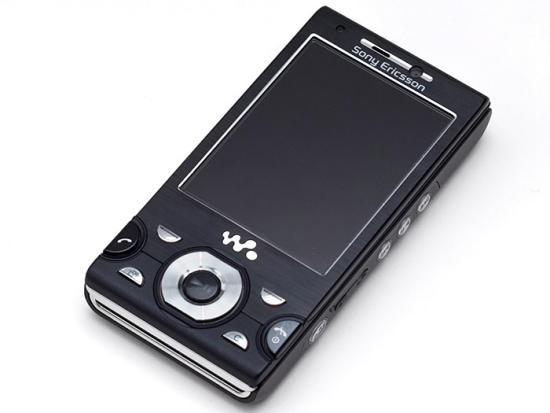
Things you’ll love about the Sony Ericsson W995
The W995 is a Walkman phone with the best features of a CyberShot cameraphone. In other words, it’s the perfect blend of both.So buy a W995 and you’ll get:
- the latest Sony Walkman 4.0 software, which is recognized as one of the best music interfaces on the market
- terrific sound quality thanks to Sony’s experience in music technology
- loads of storage for thousands of tunes, thanks to an 8GB MM2 storage card included the price
- freedom to hear your tunes with your own headphones, thanks to an industry standard 3.5mm headphone jack
- let your friends listen as well, with its large high quality built-in speakers
- FM radio
- a great 8 megapixel camera with autofocus, smile detection, face recognition and flash
- aGPS with Google Maps
- Guitar Hero-like games that make the most of the W995’s music features
- Wi-Fi, HSDPA and Quad-Band GSM support, for fast Internet downloads wherever you are
- DLNA, which lets you share music and pics between your phone and your PC or DLNA-equipped TV
- Great range of software pre-installed, including Web Browser, YouTube, Facebook, Flickr and loads of games
- Access to Sony Ericsson’s new PlayNow download service for downloading videos, apps and games
- MediaGo software, which lets you sync your tunes seamlessly with the music library on your PC
Every phone feature you could ever want
The W995 offers the best music playing software and the best sound on the market – which is at it should be, as it’s the flagship Walkman phone in Sony Ericsson’s collection.Better than that, though, rather than focusing purely on music, Sony Ericsson threw everything they could at the W995! As feature-phones go, there’s hardly anything that the W995 doesn’t have.
So not only do you get a phone that comes with a list of features as long as your arm, because it’s a Sony Ericsson, they all work really well. The photos, for example, taken from its 8.1 megapixel camera look crisp and clear – see for yourself in the sample pics below (courtesy of PhoneArena) – while the sound of its music player is excellent.


The user interface is quick and responsive too, so you won’t have to wait as you select the options you want.

There are even dedicated music buttons on the outside of the phone for super-quick access to all of your phones.
And if it’s the mobile Web you’re more interested in, the W995 scores highly there. The W995 is a fast phone in every sense – its user interface is responsive, so it’s easy and quick to scroll around a Web page, while Wi-Fi and fast HSDPA (3.6Mbps) ensure Web pages are downloaded in super-quick time.
Better still, the W995 comes with dedicated apps for Flickr, Facebook and YouTube, so you don’t even need to browse to their Web sites – you simply go there with a single click!
Any downsides?

The only problem with the W995 is its user interface, which is a bit dated. The second half of this year has seen some stunning looking phones emerge with all manner of sexy software that make the W995 look a bit, well, 2008!
In part, this is because it’s following the design of previous Walkman phones, the design of which is now a couple of years old. It’s also because Sony Ericsson underestimated the competition a bit, and didn’t realize the range of new smartphones that would be released, such as the HTC Hero, Motorola Droid and Palm Pre, would all looks so gorgeous!
It’s not that the user interface is terrible – it uses Adobe Flash, so it’s still got loads of whizzy effects, animations and transitions. But it’s not touchscreen and the world wants touchscreen phones at the moment. This, however, is the secret to the W995’s real value.
Because its not quite so attractive as other phones, Sony Ericsson have had to keep its price low in order to sell it. So if you don’t mind that your phone doesn’t look quite as cutting edge as it could, you can grab yourself one of the best-performing feature phones on the market for much less than Sony Ericsson would rather you paid!
How much less? Check out the deals on offer and see for yourself.
Video reviews of the Sony Ericsson W995
Unsure whether you want a phone without a touchscreen? Don’t be – the quality of the W995’s pictures and the sound it produces is right up there with the best. Say what you like about Sony Ericsson, but they know how to make good technology, and as the W995 is the current flagship Walkman phone, they’ve kitted it out with the best tech they’ve got.You can see for yourself the quality of the phone in the video reviews below. Imagine showing it off to your mates with its huge list of features. Sure they might have a flashy touchscreen phone, but the W995 has what really matters – quality! Your W995’s features will make their touchscreen phone look just like a gimmick – and for just half the cost!
Sony Ericsson W995 reviews from across the Web
The W995 has been reviewed extensively across the Web, with near unanimous praise.GSMArena were extremely impressed:
“Sony Ericsson W995 is the company’s top-ranking Walkman and its spec sheet is clearly set to justify this label. The Flash-based user interface, which we’ve praised repeatedly, seems to be only getting better. There are no gaps in the connectivity set and the 3.5 mm audio jack is a long-awaited blessing.PhoneArena, too, love the quality of the W995.
Sony Ericsson W995 not only spares users the agonizing choice between Walkman and Cyber-shot. It has simply harvested all the high-end goodies and leaves nothing else to want. And all that skill is packed in a compact, solid and stylish body.”
“Just a simple glance at the specs of the Sony Ericsson W995 should be enough to convince you that this is the most high-tech model of the Walkman Series. Does that mean it is the best as well? In terms of sound quality (not through the boxed earphones), camera performance and GPS, this is the case indeed.”Finally, Channel 5’s The Gadget Show also make the same point about the W995:
“…The Sony Ericsson W995 suffers from all the same drawbacks as previous Walkman mobiles: it’s walled off, and lacking the power and customization of your standard smartphone. If that doesn’t bother you though, what you’ll find is one of the best multimedia phones on the market, and this time that includes picture taking.”

Conclusion
So, should you buy the Sony Ericsson W995? If you’re looking for a feature-rich high-end mobile phone that takes great pictures and has the best in class sound system, then yes, the W995 should be top of your list!It doesn’t have the slick touchscreen user interface of the average smartphone – it’s just a straightforward high-end mobile phone. But because of that, you get to buy the W995 at a knock down price. Bad news for Sony Ericsson, but great news for you!
If you’re looking for a cracking multimedia mobile phone for Christmas at a knock-down price, then the W995 has to be the bargain of the decade. Just don’t tell anyone, or the whole world will want one!
Check out the deals below to see how much you get for your money.

Sony Ericsson has decided to take its Xperia range of phones decidedly upmarket with the launch of the Sony Ericsson Xperia Pureness.
Whereas other Xperia phones are high-end smartphone affairs that come with virtually every feature you can think of, the Xperia Pureness is, well, pure! It’s a fashion phone first and foremost, and its main claim to fame is its stunning see through screen, which can be seen on both sides of the phone.
It’s easier to see than talk about, so check out the video after the jump.
Sony Ericsson Xperia Pureness – a good idea?
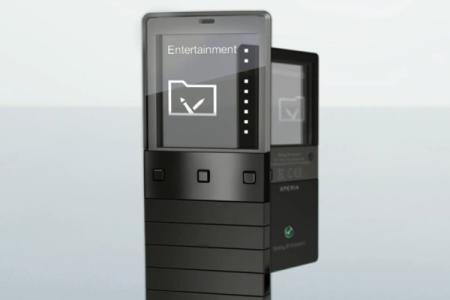
There seems to be a new trend towards see-through phones at the moment, after LG released its LG GD900 Crystal earlier in the year.
The Crystal, though, only had a see-through keypad, which anyone can do. Sony Ericsson decided to go one better and make the whole screen see-through!
The result certainly gives the Xperia Pureness the Wow factor. It looks extremely sleek, and being able to see the screen on both sides of the phone is certainly novel. It’s not particularly useful, mind, as of course the reverse side of the screen is a mirror image of the main side, which makes reading text a bit tricky; but it is at least novel!
It’s also only black and white, but this may not be such a problem, as black and white is always fashionable, and that’s exactly what you want from a fashion phone.
Sony Ericsson Xperia Pureness videos

The Xperia Pureness was known in its concept form as the Sony Ericsson Kiki, and when pictures first emerged of it with its see-through screen, everyone assumed it was a fake. It must be, there was no keypad, and how can you have a phone with a see-through screen?
Well, we still don’t know, as Sony Ericsson have been very coy about showing it off in the flesh, and have released precious few details (apart form the price – $1,000 apparently!).
But it is real, and they’ve got videos to prove it:
If you want one, the Sony Ericsson Xperia Pureness X5 release date is November 2009, so you’ll have to wait a bit. Still, at $1,000 it gives you the chance to save your pennies.
July 19th, 2009
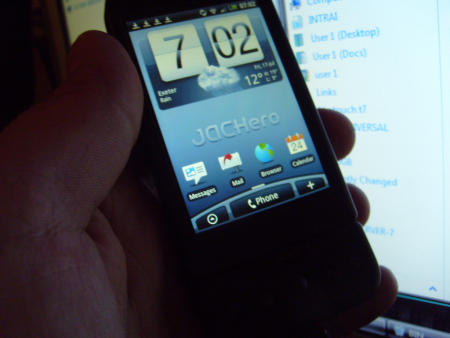
The HTC Hero is a brand new Android phone that’s due to be launched in the next week or two. One of the best features about the Hero is the fact that it has a brand new user interface – called Rosie, of all things! Rosie has bee developed by HTC to help it differentiate its Android phones from the myriad competitors that are now appearing.
The new user interface has been designed from the ground up to give Android a super-slick polished look. It’s not just a port of HTC’s TouchFLO user interface that it created for Windows Mobile. It’s a brand new dedicated Android interface that looks super-slick, has a nifty new Web browser and great new music player, among many many other enhancements.
But what if you’ve already got a T-Mobile G1 with the “vanilla” Android user interface? Are you forced to watch your HTC Hero-sporting friend gloat over the greatness of his new phone’s UI while you’re stuck with your G1’s UI for the next year or so?
Fear not. If you’ve got the technical chops, patience, and balls of steel, you too can port the HTC Hero’s user interface over to your T-Mobile G1. Be warned – it’s not easy!
But it can be done, and my brother Dave (@terminal7) has proved it by successfully upgrading his G1. You can see the pics he took of his new Hero G1, plus videos and details on how to do it after the jump.
A small warning!
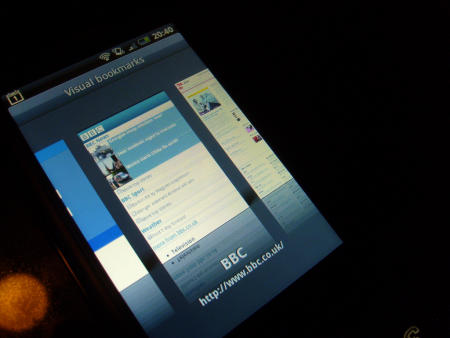
First, a small warning. If you decide to do this and you do it wrong, you may end up with a decidedly unhealthy G1. So unhealthy, in fact, it’ll have all the functionality of a brick!
Also, if you succeed, you’ll not be able to update your phone to any new Android updates that Google releases. The current version of Android is Cupcake, which added a plethora of new features to the original Android release. With the Donut, Eclair and Flan updates all scheduled for release this year, the chances are that the existing features of your G1 will be radically improved anyway without you doing a thing. If you choose to port the Hero’s interface to your G1, you won’t be able to use any of these.
That said, the Hero’s new Rosie User Interface is so cool, you may not actually care about the official Google updates!
What do you get with the HTC Hero user interface?
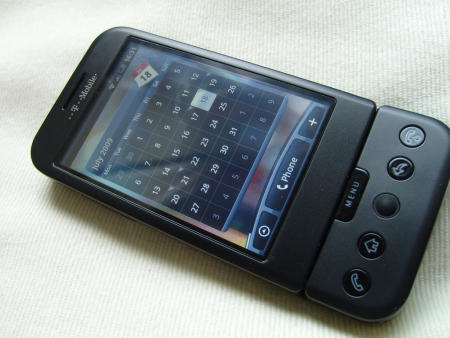
Before you decide to do this, though, you obviously need to know whether or not it’s worth it. In other words, what do you get with the HTC Hero’s Rosie UI that you don’t get with the G1?
Well, I’ll give a full run-down of the Hero’s features later in the week when I do a full HTC Hero review, but in the meantime, here’s a taster:
- Updated Web browser – lets you see the whole Web page on screen and easily swipe through pages in the browser’s history
- Updated interface – brand new set of icons and flashy user interface widgets makes existing apps such as email look much, much better
- Nifty new calendar – the calendar’s been updated and is much easier to use
- New music player – navigate your music playlists in a brand new media player
- New media gallery – view your images in a much sexier gallery app
For more on the Hero’s features, check out the pics taken by my brother Dave of his updated G1 (bottom of this post), or check out this video of the Hero interface successfully bolted onto the G1.
How to turn your T-Mobile G1 into an HTC Hero
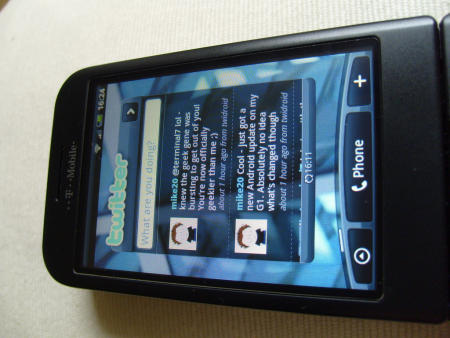
And now for the fun bit – or should that be the scary bit – actually porting the Hero interface over to your G1.
According to Dave, it’s simple. Just do the following:
“After downgrading to pre-Cupcake firmware 1.0, then running telnet and rooting the thing, then flashing a new radio rom, then installing a new SPL, then installing a recovery image application, which I still cant seem to operate, then partitioning an SD card into 3 – and in 3 different file systems ! – then finally flashing a new build ROM from Haykuro and Jachero, it’s all done…!”
Ahem! Told you this wasn’t easy!
In a less breathless approach, the way to go about this is to follow the instructions over at XDA Developers, or just ask my brother Dave on Twitter (@terminal7). Not entirely sure how much help he can be with just 140 characters to play with, but I’m sure he’ll help where he can.
Pictures of the HTC Hero interface on the G1
Right, now for all the glorious pics of HTC’s Rosie on the G1. Now tell me you don’t want to do this ;)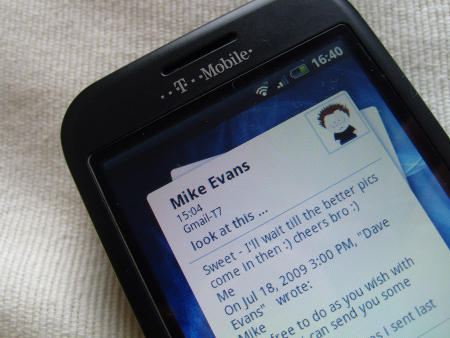
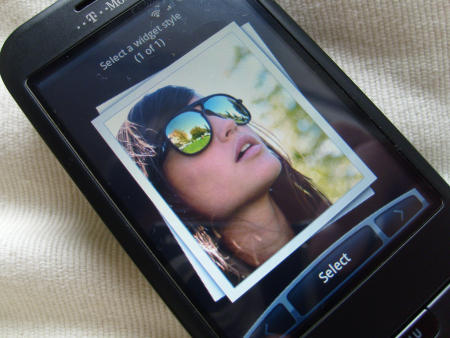

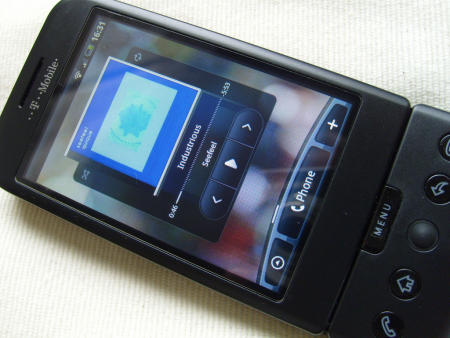
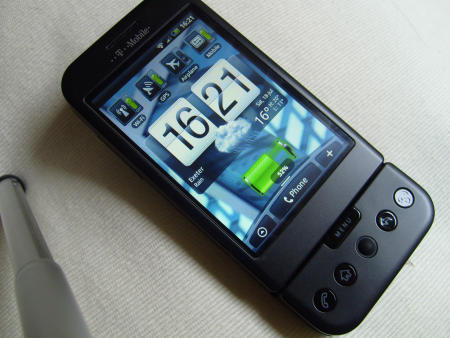
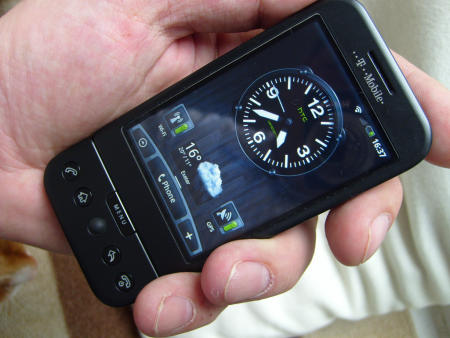
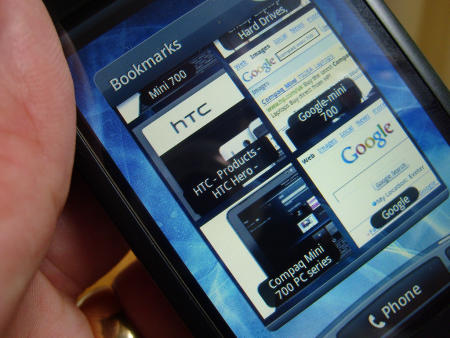



















If you’re raring to get one of the $197 laptops, you’d better get their super early! Only 5 will be available at each store and there is a strict limit of one per customer.